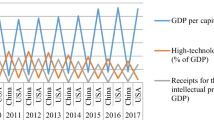Abstract
This essay evaluates the impacts of knowledge-based economy factors on the total factor productivity (TFP) of emerging economies (the countries known as emerging economies are Brazil, Russia, India, China, South Korea, South Africa, and Singapore) and compares them with G7 economies using panel data analysis during 1996–2013. The results indicate that the ratio of ICT capital stock to GDP and the ratio of foreign R&D capital stock to GDP have the greatest positive impact on TFP, respectively, in emerging economies. But the ratio of domestic R&D capital stock to GDP and the ratio of education costs to GDP in emerging economies comparing to the developed countries of G7 have a less influential impact on TFP. However, in these countries, we see the positive effect of foreign R&D stock through the acquisition of commercial partners’ technologies via imports and customizing them according to local needs and using this factor beside domestic R&D activities which provides a proper atmosphere for improvement of TFP and approaching a knowledge-based economy.
Similar content being viewed by others
Notes
Bangladesh, Bolivia, Bulgaria, Cameron, Chile, Columbia, Cyprus, Ecuador, Egypt, Salvador, Ethiopia, Greece, Guatemala, Hong Kong, Hungary, India, Indonesia, Iran, Israel, Jordan, Kenya, Korea, Kuwait, Latvia, Macao (china), Malawi, Malaysia, Malta, Mexico, Morocco, Burma, Nepal, Nigeria, Oman, Pakistan, Panama, Peru, the Philippines, Poland, Romania, Senegal, Singapore, Slovenia, Sri Lanka, Tanzania, Trinidad and Tobago, Tunisia, Turkey, Uruguay, Venezuela
Australia, Belgium, Canada, Denmark, Finland, France, Germany, Italy, Japan, the Netherland, Norway, Portugal, Spain, Sweden, England, USA
References
Aghion, P., & Howitt, P. (1992). A model of growth through creative destruction. Econometrica, 60(2), 323–351.
Aigner, D.J., Hsiao, C., Kapteyn, A., and Wansbeek, T. (1984). Latent variable models in econometrics. In Z. Griliches and M. D. Intriligator, (Eds.), Handbook of Econometrics, Vol. 2, (pp. 1322–1393). North– Holland.
Amini, A., & Hejazi-Azad, Z. (2008). Analysis of human investment and research and development role in improvement of productivity of total elements in Iran economy. Journal of Economic Researches of Iran, 35, 1–30 (in persian).
Coe, D., & Helpman, E. (1995). International R&D spillovers. European Economic Review, 39(2), 859–887.
Coe, D., Helpman, E., & Hoffmaister, W. (2009). International R&D spillovers and institutions. Journal of European Economic Review, 53(7), 224–225.
Coe, D., & Hoffmaister, A. (1997). North-South R&D Spillovers. Economic Journal, 107, 134–149.
Coe, D., & Hoffmaister, A. (1999). “Are There International Spillovers Among Randomly Matched Trade Partners? A Response to Keller”, IMF Working Paper No. 99/18. Washington: International Monetary Fund.
Fraumeni, B. M. (1997). The measurement of depreciation in the U.S. national income and product Accounts. Survey of Current Business, 14(1), 7–23.
Griliches, Z. (1988). Productivity puzzles and R&D: another no explanation. Journal of Economic Perspectives, 56(2), 9–21.
Grossman, G. M., & Helpman, E. (1991). Innovation and growth in the global economy. Cambridge: The MIT press.
Heshmati, A., & Shiu, A. (2006). Technical Change and Total Factor Productivity Growth for Chinese Provinces: A Panel Data Analysis. IZA Discussion Papers, 2133.
Jorgenson, D. W. (2001). Information technology and US economy. American Economic Review, 44(91), 1–32.
Mahmoud Zadeh, M., & Razaghi, H. (2011). The Impact of ICT Spillovers on the Total factors Productivity growth in selected developing countries. Journal of Eghtesad va Tejarat-e-Novin, 13, 1–21. (in persian).
Matteucci, N., & Sterlacchini, A. (2005). ICT, R&D and productivity growth: evidence from Italian manufacturing firms. Ancona: University Politecnica delle Marche.
Mendi, P. (2007). Trade in disembodied technology and total factor productivity in OECD countries. Research Policy, 27(36), 121–133.
Musolesi, A. (2007). R&D and productivity in 16 OECD countries: some heterogeneous panel estimations.Applied. Economics Letters, 14(7), 493–496.
Rahmani, T., & Hayati, S. (2007). The Survey of ICT impacts on the Total factors Productivity growth; a cross country study. Journal of Iranian Economic Studies, 33, 25–51.
Romer, P. M. (1987). Crazy explanations for the productivity slowdown. Macroeconomic Annual, 163–210.
Romer, P. M. (1990). Endogenous technical change. Journal of Political Economy, 98(2), 71–102.
Schiff, M., & Wang, Y. (2009). North–south trade-related technology diffusion and productivity growth: are small states different? Available at SSRN: http://ssrn.com/abstract=1333627 or http://dx.doi.org/10.2139/ssrn.1333627.
Seo, H.-J., & Lee, S. L. (2006). Contribution of information and communication technology to total factor productivity and externalities affects. Information Technology for Development, 12(2), 159–173.
Shahabadi, A. (2003). An investigation of the determining factors in Iran ׳s total factor productivity”. Nameh-YEMofid, 9(38), 27–56 (in Persian).
Shahabadi, A., & Rahmani, O. (2008). Effect of foreign and domestic R&D capital stock on TFP growth in Iran's manufacturing sector”. Quarterly Journal of New Economy & Commerce, 4(14), 18–38 (in Persian).
Shahabadi, A., & Rahmani, O. (2011). A review on research and development impacts on Iran’s industrial sector productivity”. Roshd-E-Fanavari, 7(25), 28–38 (in Persian).
Shiu, A., & Heshmati, A. (2006). Technical change and total factor productivity growth for Chinese provinces: a panel data analysis. IZA, Discussion Paper No. 2133, pp. 103–119.
Tayyebi, K., Emadzadeh, M., & Sheykhbahaei, A. (2008). Impacts of Industrial exports on the human capital, Total factors productivity and Economic growth in OIC countries. Journal of Quantitative Economy, 5(2), 85–106.
Author information
Authors and Affiliations
Corresponding author
Rights and permissions
About this article
Cite this article
Shahabadi, A., Kimiaei, F. & Arbab Afzali, M. The Evaluation of Impacts of Knowledge-Based Economy Factors on the Improvement of Total Factor Productivity (a Comparative Study of Emerging and G7 Economies). J Knowl Econ 9, 896–907 (2018). https://doi.org/10.1007/s13132-016-0379-3
Received:
Accepted:
Published:
Issue Date:
DOI: https://doi.org/10.1007/s13132-016-0379-3



